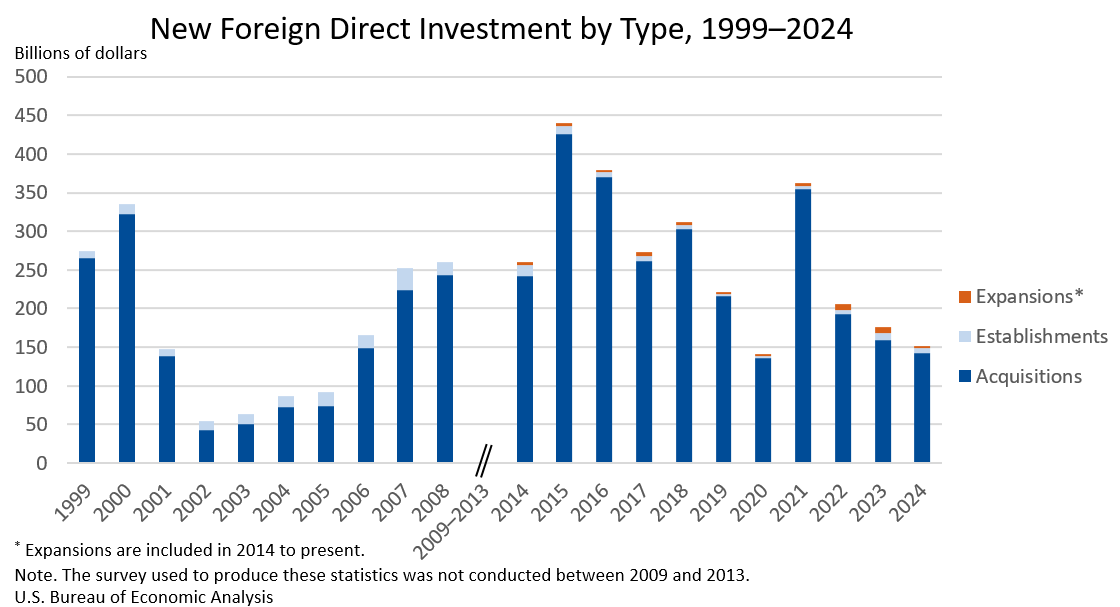Bureau of Economic Analysis
New Foreign Direct Investment in the United States, 2024
Expenditures by foreign direct investors to acquire, establish, or expand U.S. businesses totaled $151.0 billion in 2024, according to preliminary statistics released today by the U.S. Bureau of Economic Analysis. Expenditures decreased $24.9 billion, or 14.2 percent, from $176.0 billion (revised) in 2023 and were below the annual average of $277.2 billion for 2014–2023. As in previous years, acquisitions of existing U.S. businesses accounted for most of the expenditures.
Principal Federal Economic Indicators
Noteworthy
- 2025 News Release Schedule
- Innovation at BEA
- 2025 Annual Updates
- New! Services Trade Data for More Countries
- Data Tool: Trade in Value Added
- Distribution of State Personal Income
- Updated: RIMS II Regional Multipliers
- Arts and Culture
- Space Economy
- FDI Now in State BEARFACTS
- Quick Guide: Price Indexes
The Latest
Expanded Geographic Detail on International Trade in Services Coming Soon
How much do U.S. residents spend on travel to Greece? How much does the U.S. export in movies and television programming to Vietnam? You can answer these questions next week when the Bureau of Economic Analysis expands the geographic detail it publishes on U.S. imports and exports of services. On October 24, we will publish annual statistics on international trade in services with 90 countries and areas, up from 49.
County GDP Stats Would Give a Closer Look at Local Economies
Anyone interested in economic growth in, let’s say, West Virginia can check state GDP data from the U.S. Bureau of Economic Analysis. Want to zoom in on a metro area, such as Charleston, W.Va., and its surroundings? BEA has gross domestic product by metropolitan areas, too.
August 2016 Trade Gap is $40.7 Billion
The U.S. monthly international trade deficit increased in August 2016 according to the U.S. Bureau of Economic Analysis and the U.S. Census Bureau. The deficit increased from $39.5 billion in July (revised) to $40.7 billion in August, as imports increased more than exports. The previously published July deficit was $39.5 billion. The goods deficit decreased less than $0.1 billion in August to $60.3 billion. The services surplus decreased $1.2…
U.S. International Trade in Goods and Services, August 2016
U.S. Census Bureau U.S. Bureau of Economic Analysis NEWS U.S. Department of Commerce * Washington, DC 20230 U.S. INTERNATIONAL TRADE IN GOODS AND SERVICES August 2016 The U.S. Census Bureau and the U.S. Bureau of Economic Analysis, through the Department of Commerce, announced today that the goods and services deficit was $40.7 billion in August, up $1.2 billion from $39.5 billion in July,…
Personal Consumption Expenditures by State, 2015
Growth in state personal consumption expenditures (PCE) – the measure of goods and services purchased by or on behalf of households – decelerated to 3.6 percent in 2015 from 4.4 percent in 2014. In 2015, growth in PCE was largely concentrated in the Far West and Rocky Mountain regions.
Personal Consumption Expenditures by State, 2015
Growth in state personal consumption expenditures (PCE) – the measure of goods and services purchased by or on behalf of households – decelerated to 3.6 percent on average in 2015 from 4.4 percent in 2014 (Table 1), according to statistics released today by the Bureau of Economic Analysis. In 2015, PCE growth ranged from 1.5 percent in Wyoming to 5.0 percent in Florida.
Spending on Durable Goods Falls in August
Personal income increased 0.2 percent in August after increasing 0.4 percent in July. Wages and salaries, the largest component of personal income, increased 0.1 percent in August after increasing 0.5 percent in July.
Personal Income and Outlays, August 2016
Personal income increased $39.3 billion (0.2 percent) in August according to estimates released today by the Bureau of Economic Analysis. Disposable personal income (DPI) increased $31.9 billion (0.2 percent) and personal consumption expenditures (PCE) increased $6.2 billion (less than 0.1 percent). Real DPI increased 0.1 percent in August and Real PCE decreased 0.1 percent. The PCE price index increased 0.1 percent.
GDP Increases in Second Quarter
Real gross domestic product (GDP) increased 1.4 percent in the second quarter of 2016, according to the “third” estimate released by the Bureau of Economic Analysis. The growth rate was 0.3 percentage point higher than the “second” estimate released in August. In the first quarter, real GDP rose 0.8 percent.
Gross Domestic Product, 2nd quarter 2016 (third estimate); Corporate Profits, 2nd quarter 2016 (revised estimate)
Real gross domestic product increased at an annual rate of 1.4 percent in the second quarter of 2016 (table 1), according to the "third" estimate released by the Bureau of Economic Analysis. In the first quarter, real GDP increased 0.8 percent. The GDP estimate released today is based on more complete source data than were available for the "second" estimate issued last month. In the second estimate, the increase in real GDP was 1.1 percent.…




